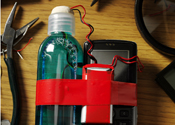TEDAC
Terrorist Explosive Device Analytical Center (TEDAC)
Overview
The Terrorist Explosive Device Analytical Center (TEDAC) was formally established in 2003 to serve as the single interagency organization to receive, fully analyze, and exploit all terrorist improvised explosive devices, or IEDs, of interest to the United States. TEDAC coordinates the efforts of the entire government, from law enforcement to intelligence to military, to gather and share intelligence about these devices—helping to disarm and disrupt IEDs, link them to their makers, and, most importantly, prevent future attacks. To date, TEDAC has received tens of thousands of IED submissions, primarily from Iraq and Afghanistan.
TEDAC consists of a director (FBI), a deputy director (Bureau of Alcohol, Tobacco, Firearms, and Explosives), a Department of Defense executive manager (Joint Improvised Explosive Device Defeat Organization, or JIEDDO), and five units relating to forensics, technical exploitation, intelligence, and investigations. TEDAC includes representatives from the Department of Justice; the Department of Defense; international partner agencies; and members of the intelligence community.
TEDAC is located at Redstone Arsenal in Huntsville, Alabama.
Mission
The mission of TEDAC is to directly contribute to the eradication of the IED threat. TEDAC informs its partners, who disrupt those individuals and networks responsible for the design, development, purchase, assembly, and deployment of IEDs by providing:
- Scientific and technical exploitation of IEDs through physical examination utilizing established and innovative forensic techniques;
- Actionable intelligence related to device attributes and terrorist tactics, techniques, and procedures made available to intelligence and law enforcement partners;
- Timely response according to partners’ priority requests for intelligence, device exploitation, data, and analysis;
- Forecasts of IED-related threats worldwide through research and development and the production and dissemination of finished intelligence products by leveraging deliberate scientific and technical analysis of IEDs; and a
- Centralized repository for IED-related material collected through liaison and strategic partnering.
TEDAC’s Work
TEDAC provides direct support to broader U.S. government efforts to prevent and mitigate improvised explosive device (IED) attacks by performing advanced exploitation of IEDs through physical examination resulting in scientific and technical information and intelligence of value. Through its integration of intelligence resources, TEDAC also provides expeditious reporting of raw and finished intelligence involving device attributes and terrorist tactics, techniques, and procedures to intelligence and law enforcement partners to enhance knowledge and understanding of current and future threats.
TEDAC’s continued success relies on a whole-of-government approach to addressing the IED threat. By serving as a collaborative, multi-agency, single-point advanced IED analytical center, TEDAC is able to identify actionable intelligence, make associations between devices, and communicate findings to a broad customer base consisting of state and local law enforcement, the U.S. military, the intelligence community, and partner nations. In addition, through its demonstrated capacity to disseminate raw intelligence, TEDAC serves a key role in broader FBI efforts to acquire, analyze, act on, and share terrorist-related information.
TEDAC performs IED exploitation using both established and novel forensic techniques. The center performs these activities in a high-capacity, multi-agency, collaborative environment using experienced scientists, engineers, and technicians.
08.16.10



